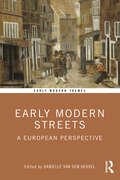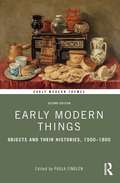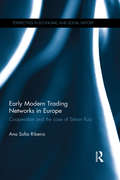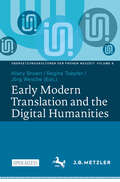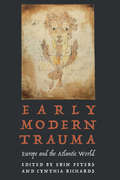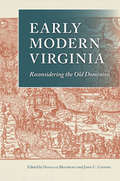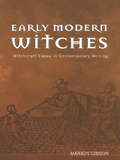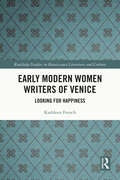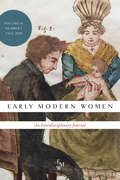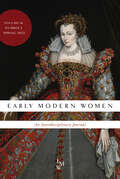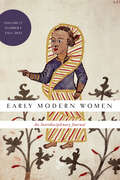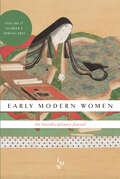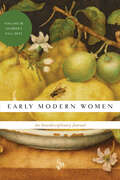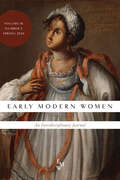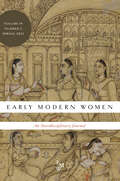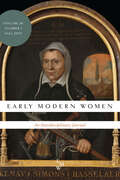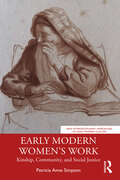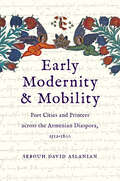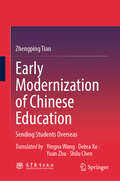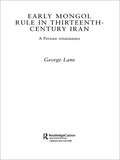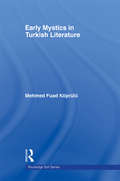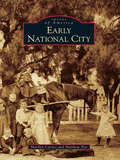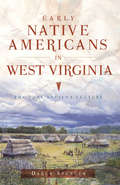- Table View
- List View
Early Modern Streets: A European Perspective (Early Modern Themes)
by Danielle van den HeuvelFor the first time, Early Modern Streets unites the diverse strands of scholarship on urban streets between circa 1450 and 1800 and tackles key questions on how early modern urban society was shaped and how this changed over time. Much of the lives of urban dwellers in early modern Europe were played out in city streets and squares. By exploring urban spaces in relation to themes such as politics, economies, religion, and crime, this edited collection shows that streets were not only places where people came together to work, shop, and eat, but also to fight, celebrate, show their devotion, and express their grievances. The volume brings together scholars from different backgrounds and applies new approaches and methodologies to the historical study of urban experience. In doing so, Early Modern Streets provides a comprehensive overview of one of the most dynamic fields of scholarship in early modern history. Accompanied by over 50 illustrations, Early Modern Streets is the perfect resource for all students and scholars interested in urban life in early modern Europe.
Early Modern Things: Objects and their Histories, 1500-1800 (Early Modern Themes)
by Paula FindlenEarly Modern Things supplies fresh and provocative insights into how objects – ordinary and extraordinary, secular and sacred, natural and man-made – came to define some of the key developments of the early modern world. Now in its second edition, this book taps a rich vein of recent scholarship to explore a variety of approaches to the material culture of the early modern world (c. 1500–1800). Divided into seven parts, the book explores the ambiguity of things, representing things, making things, encountering things, empires of things, consuming things, and the power of things. This edition includes a new preface and three new essays on ‘encountering things’ to enrich the volume. These look at cabinets of curiosities, American pearls, and the material culture of West Central Africa. Spanning across the early modern world from Ming dynasty China and Tokugawa Japan to Siberia and Georgian England, from the Kingdom of the Kongo and the Ottoman Empire to the Caribbean and the Spanish Americas, the authors provide a generous set of examples in how to study the circulation, use, consumption, and, most fundamentally, the nature of things themselves. Drawing on a broad range of disciplinary perspectives and lavishly illustrated, this updated edition of Early Modern Things is essential reading for all those interested in the early modern world and the history of material culture.
Early Modern Toleration: New Approaches (Early Modern Themes)
by Jaap GeraertsThis book examines the practice of toleration and the experience of religious diversity in the early modern world. Recent scholarship has shown the myriad ways in which religious differences were accommodated in the early modern era (1500–1800). This book propels this revisionist wave further by linking the accommodation of religious diversity in early modern communities to the experience of this diversity by individuals. It does so by studying the forms and patterns of interaction between members of different religious groups, including Christian denominations, Muslims, and Jews, in territories ranging from Europe to the Americas and South-East Asia. This book is structured around five key concepts: the senses, identities, boundaries, interaction, and space. For each concept, the book provides chapters based on new, original research plus an introduction that situates the chapters in their historiographic context. Early Modern Toleration: New Approaches is aimed primarily at undergraduate and postgraduate students, to whom it offers an accessible introduction to the study of religious toleration in the early modern era. Additionally, scholars will find cutting-edge contributions to the field in the book’s chapters.
Early Modern Trading Networks in Europe: Cooperation and the case of Simon Ruiz (Perspectives In Economic And Social History Ser.)
by AnaSofia RibeiroIn the early modern period, trade became a truly global phenomenon. The logistics, financial and organizational complexity associated with it increased in order to connect distant geographies and merchants from different backgrounds. How did these merchants prevent their partners from dishonesty in a time where formal institutions and legislation did not traverse these different worlds? This book studies the mechanisms and criteria of cooperation in early modern trading networks. It uses an interdisciplinary approach, through the case study of a Castilian long-distance merchant of the sixteenth century, Simon Ruiz, who traded within the limits of the Portuguese and Spanish overseas empires. Early Modern Trading Networks in Europe discusses the importance of reciprocity mechanisms, trust and reputation in the context of early modern business relations, using network analysis methodology, combining quantitative data with qualitative information. It considers how cooperation and prevention could simultaneously create a business relationship, and describes the mechanisms of control, policing and punishment used to avoid opportunism and deception among a group of business partners. Using bills of exchange and correspondence from Simon Ruiz�s private archive, it charts the evolution of this business network through time, debating which criteria should be included or excluded from business networks, as well as the emergence of standards. This book intends to put forward a new approach to early modern trade which focusses on individuals interacting in self-organized structures, rather than on States or Empires. It shows how indirect reciprocity was much more frequent than direct reciprocity among early modern merchants and how informal norms, like ostracism and signalling, helped to prevent defection and deception in an effective way. This book will be of interest to all early modern historians, especially those with an interest
Early Modern Translation and the Digital Humanities (Übersetzungskulturen der Frühen Neuzeit #8)
by Hilary Brown Regina Toepfer Jörg WescheThis open-access volume explores how digital resources and methods can be usefully employed for research on early modern translation. The volume focuses mainly on digital resources, and features a number of chapters on translation-specific resources written by members of the teams leading the projects. The resources presented here encompass translations into and/or out of Greek, Latin, the European vernaculars, and Jewish languages (Hebrew, Yiddish, Ladino and Judeo-Italian) and different corpora including plays, encyclopedias, and ‘radical’ texts. While the use of digital methods to analyse early modern translations is still in its early stages, the volume also considers how methods such as data visualisation could shed new light on translation phenomena.
Early Modern Trauma: Europe and the Atlantic World (Early Modern Cultural Studies)
by Erin Peters Cynthia RichardsThe term trauma refers to a wound or rupture that disorients, causing suffering and fear. Trauma theory has been heavily shaped by responses to modern catastrophes, and as such trauma is often seen as inherently linked to modernity. Yet psychological and cultural trauma as a result of distressing or disturbing experiences is a human phenomenon that has been recorded across time and cultures. The long seventeenth century (1598–1715) has been described as a period of almost continuous warfare, and the sixteenth to eighteenth centuries saw the development of modern slavery, colonialism, and nationalism, and witnessed plagues, floods, and significant sociopolitical, economic, and religious transformation. In Early Modern Trauma editors Erin Peters and Cynthia Richards present a variety of ways early modern contemporaries understood and narrated their experiences. Studying accounts left by those who experienced extreme events increases our understanding of the contexts in which traumatic experiences have been constructed and interpreted over time and broadens our understanding of trauma theory beyond the contemporary Euro-American context while giving invaluable insights into some of the most pressing issues of today.
Early Modern Virginia: Reconsidering the Old Dominion (Early American Histories)
by Douglas Bradburn John C. CoombsThis collection of essays on seventeenth-century Virginia, the first such collection on the Chesapeake in nearly twenty-five years, highlights emerging directions in scholarship and helps set a new agenda for research in the next decade and beyond. The contributors represent some of the best of a younger generation of scholars who are building on, but also criticizing and moving beyond, the work of the so-called Chesapeake School of social history that dominated the historiography of the region in the 1970s and 1980s. Employing a variety of methodologies, analytical strategies, and types of evidence, these essays explore a wide range of topics and offer a fresh look at the early religious, political, economic, social, and intellectual life of the colony.ContributorsDouglas Bradburn, Binghamton University, State University of New York * John C. Coombs, Hampden-Sydney College * Victor Enthoven, Netherlands Defense Academy * Alexander B. Haskell, University of California Riverside * Wim Klooster, Clark University * Philip Levy, University of South Florida * Philip D. Morgan, Johns Hopkins University * William A. Pettigrew, University of Kent * Edward DuBois Ragan, Valentine Richmond History Center * Terri L. Snyder, California State University, Fullerton * Camilla Townsend, Rutgers University * Lorena S. Walsh, Colonial Williamsburg Foundation
Early Modern Witches: Witchcraft Cases in Contemporary Writing
by Marion GibsonThis collection of pamphlets describes fifteen English witchcraft cases in detail, vividly recreating events to give the reader the illusion of actually being present at witchcraft accusations, trials and hangings. But how much are we victims of literary manipulation by these texts? The pamphlets are presented in annotated format, to allow the reader to decide. Some of the texts appear in print for the first time in three centuries, whilst others are newly edited to give a clearer picture of sources.
Early Modern Women Writers of Venice: Looking for Happiness (Routledge Studies in Renaissance Literature and Culture)
by Kathleen FrenchEarly Modern Women Writers of Venice: Looking for Happiness explores the ways in which five women used their writing to challenge misogynistic views about female inferiority, develop a sense of agency, and form meaningful interpersonal relationships that would enable them to find happiness. They are the forerunners of later feminist thinkers.This book is the first full-length study of the happiness of women in early modern Italy. It focuses on five women writers who lived in Venice between the late fifteenth century and the early seventeenth century. It takes an interdisciplinary approach that combines methodologies from literature, psychology, philosophy, history, religion, and emotion studies, emphasizing the importance of studying the search for happiness within a specific cultural context. It contributes particularly to feminist studies that consider gender in the context of ideology and the exercise of power. It also engages with current studies of emotions by approaching them from the perspective of research in the field of positive psychology and self-determination theory. It considers how the process of writing enabled women to achieve autonomy, what they thought about happiness, and the extent to which they were able to achieve it in their individual lives.
Early Modern Women: An Interdisciplinary Journal, volume 16 number 1 (Fall 2021)
by Early Modern Women: An Interdisciplinary JournalThis is volume 16 issue 1 of Early Modern Women: An Interdisciplinary Journal. Early Modern Women: An Interdisciplinary Journal (EMW) is the only journal devoted solely to the interdisciplinary and global study of women and gender spanning the late medieval through early modern periods. Each volume gathers essays on early modern women from every country and region by scholars from a wide range of academic disciplines including art history, cultural studies, music, history, languages and literatures, political science, religion, theatre, history of science, and history of philosophy.
Early Modern Women: An Interdisciplinary Journal, volume 16 number 2 (Spring 2022)
by Early Modern Women: An Interdisciplinary JournalThis is volume 16 issue 2 of Early Modern Women: An Interdisciplinary Journal. Early Modern Women: An Interdisciplinary Journal (EMW) is the only journal devoted solely to the interdisciplinary and global study of women and gender spanning the late medieval through early modern periods. Each volume gathers essays on early modern women from every country and region by scholars from a wide range of academic disciplines including art history, cultural studies, music, history, languages and literatures, political science, religion, theatre, history of science, and history of philosophy.
Early Modern Women: An Interdisciplinary Journal, volume 17 number 1 (Fall 2022)
by Early Modern Women: An Interdisciplinary JournalThis is volume 17 issue 1 of Early Modern Women: An Interdisciplinary Journal. Early Modern Women: An Interdisciplinary Journal (EMW) is the only journal devoted solely to the interdisciplinary and global study of women and gender spanning the late medieval through early modern periods. Each volume gathers essays on early modern women from every country and region by scholars from a wide range of academic disciplines including art history, cultural studies, music, history, languages and literatures, political science, religion, theatre, history of science, and history of philosophy.
Early Modern Women: An Interdisciplinary Journal, volume 17 number 2 (Spring 2023)
by Early Modern Women: An Interdisciplinary JournalThis is volume 17 issue 2 of Early Modern Women: An Interdisciplinary Journal. Early Modern Women: An Interdisciplinary Journal (EMW) is the only journal devoted solely to the interdisciplinary and global study of women and gender spanning the late medieval through early modern periods. Each volume gathers essays on early modern women from every country and region by scholars from a wide range of academic disciplines including art history, cultural studies, music, history, languages and literatures, political science, religion, theatre, history of science, and history of philosophy.
Early Modern Women: An Interdisciplinary Journal, volume 18 number 1 (Fall 2023)
by Early Modern Women: An Interdisciplinary JournalThis is volume 18 issue 1 of Early Modern Women: An Interdisciplinary Journal. Early Modern Women: An Interdisciplinary Journal (EMW) is the only journal devoted solely to the interdisciplinary and global study of women and gender spanning the late medieval through early modern periods. Each volume gathers essays on early modern women from every country and region by scholars from a wide range of academic disciplines including art history, cultural studies, music, history, languages and literatures, political science, religion, theatre, history of science, and history of philosophy.
Early Modern Women: An Interdisciplinary Journal, volume 18 number 2 (Spring 2024)
by Early Modern Women: An Interdisciplinary JournalThis is volume 18 issue 2 of Early Modern Women: An Interdisciplinary Journal. Early Modern Women: An Interdisciplinary Journal (EMW) is the only journal devoted solely to the interdisciplinary and global study of women and gender spanning the late medieval through early modern periods. Each volume gathers essays on early modern women from every country and region by scholars from a wide range of academic disciplines including art history, cultural studies, music, history, languages and literatures, political science, religion, theatre, history of science, and history of philosophy.
Early Modern Women: An Interdisciplinary Journal, volume 19 number 1 (Fall 2024)
by Early Modern Women: An Interdisciplinary JournalThis is volume 19 issue 1 of Early Modern Women: An Interdisciplinary Journal. Early Modern Women: An Interdisciplinary Journal (EMW) is the only journal devoted solely to the interdisciplinary and global study of women and gender spanning the late medieval through early modern periods. Each volume gathers essays on early modern women from every country and region by scholars from a wide range of academic disciplines including art history, cultural studies, music, history, languages and literatures, political science, religion, theatre, history of science, and history of philosophy.
Early Modern Women: An Interdisciplinary Journal, volume 19 number 2 (Spring 2025)
by Early Modern Women: An Interdisciplinary JournalThis is volume 19 issue 2 of Early Modern Women: An Interdisciplinary Journal. Early Modern Women: An Interdisciplinary Journal (EMW) is the only journal devoted solely to the interdisciplinary and global study of women and gender spanning the late medieval through early modern periods. Each volume gathers essays on early modern women from every country and region by scholars from a wide range of academic disciplines including art history, cultural studies, music, history, languages and literatures, political science, religion, theatre, history of science, and history of philosophy.
Early Modern Women: An Interdisciplinary Journal, volume 20 number 1 (Fall 2025)
by Early Modern Women: An Interdisciplinary JournalThis is volume 20 issue 1 of Early Modern Women: An Interdisciplinary Journal. Early Modern Women: An Interdisciplinary Journal (EMW) is the only journal devoted solely to the interdisciplinary and global study of women and gender spanning the late medieval through early modern periods. Each volume gathers essays on early modern women from every country and region by scholars from a wide range of academic disciplines including art history, cultural studies, music, history, languages and literatures, political science, religion, theatre, history of science, and history of philosophy.
Early Modern Women’s Work: Kinship, Community, and Social Justice (New Interdisciplinary Approaches to Early Modern Culture)
by Patricia Anne SimpsonEarly Modern Women’s Work examines the contributions of female writers, artists, scientists, religious leaders, and patrons who engaged in entrepreneurial, intellectual, and emotional labor in German-speaking Europe. Through individual and collective authorship, the women analyzed in this study assert a claim to kinship and community, often beyond the hegemonic, heteronormative relationships to family, religion, and monarch.The contributions of early modern women to the construction of productive work spaces and the establishment of intellectual and actual communities are often overlooked or underestimated in scholarship on this period. This book serves as a cultural corrective to suppositions of gender-coded work, because alongside the dominant history of the private sphere as a feminine domain, a counter-narrative emerges with collective authorship. Despite the disparities in their biographies, the women whose work Simpson foregrounds highlight a range of early modern concerns, primarily but not exclusively in German-speaking Europe. These include debates about women’s education and erudition; migration and displacement in search of religious or professional freedom; a persistent but varied discourse about female authorship and creative agency; and the assertion of subjectivity against the violent, fractious history of the Thirty Years’ War and beyond.This book will be an ideal resource for students, scholars, and all those interested in German and European studies, women and gender studies, and the history of early modern work.
Early Modernity and Mobility: Port Cities and Printers across the Armenian Diaspora, 1512-1800
by Sebouh David AslanianA history of the continent-spanning Armenian print tradition in the early modern period Early Modernity and Mobility explores the disparate yet connected histories of Armenian printing establishments in early modern Europe and Asia. From 1512, when the first Armenian printed codex appeared in Venice, to the end of the early modern period in 1800, Armenian presses operated in nineteen locations across the Armenian diaspora. Linking far-flung locations in Amsterdam, Livorno, Marseille, Saint Petersburg, and Astrakhan to New Julfa, Madras, and Calcutta, Armenian presses published a thousand editions with more than half a million printed volumes in Armenian script. Drawing on extensive archival research, Sebouh David Aslanian explores why certain books were published at certain times, how books were sold across the diaspora, who read them, and how the printed word helped fashion a new collective identity for early modern Armenians. In examining the Armenian print tradition Aslanian tells a larger story about the making of the diaspora itself. Arguing that “confessionalism” and the hardening of boundaries between the Armenian and Roman churches was the “driving engine” of Armenian book history, Aslanian makes a revisionist contribution to the early modern origins of Armenian nationalism.
Early Modernization of Chinese Education: Sending Students Overseas
by Zhengping TianThis book offers readers a comprehensive overview of the Chinese educational modernization process, during which thousands of Chinese students studied overseas to find solutions for the reform of feudal education. The led to significant educational modernization between 1860 and 1940. Five topics are covered: the reasons Chinese students studied overseas; the three vital transmissions of the overseas study trend during these 80 years; returning students and the establishment and development of modern Chinese education science; overseas students and Chinese modern educational reform; and returning students and the establishment and development of the modern Chinese higher education system. The book is of interest to high school students, undergraduates and graduates in the fields of Chinese modern history and culture, Chinese educational modernization and modern Chinese education reform.
Early Mongol Rule in Thirteenth-Century Iran: A Persian Renaissance (Routledge Studies in the History of Iran and Turkey)
by George E. LaneAn account of the re-emergence of Persia as a world player and the reassertion of its cultural, political and spiritual links with Turkic Lands, this book opposes the way in which, for too long, the whole period of Mongol domination of Iran has been viewed from a negative standpoint. Though arguably the initial irruption of the Mongols brought little comfort to those in its path, this is not the case with the second 'invasion' of the Chinggisids. This study demonstrates that Hülegü Khan was welcomed as a king and a saviour after the depredations of his predecessors, rather than as a conqueror, and that the initial decades of his dynasty's rule were characterised by a renaissance in the cultural life of the Iranian plateau.
Early Mystics in Turkish Literature (Routledge Sufi Series)
by Mehmed Fuad KopruluThis book is a translation of one of the most important Turkish scholarly works of the twentieth century. It was the masterpiece of M.F. Koprulu, one of Turkey’s leading, and most prolific, intellectuals and scholars. Using a wide variety of Arabic, and especially Turkish and Persian sources, this book sheds light on the early development of Turkish literature and attempts to show the continuity in this development between the Turks and that of Anatolia. Early Mystics in Turkish Literature addresses this topic within the context of other subjects, including Sufism, Islam and the genesis of Turkish culture in the Muslim world. This is a major contribution to the study of Turkish literature and is essential reading for scholars of Turkish literature, Islam, Sufism and Turkish history.
Early National City (Images of America)
by Marilyn Carnes Matthew NyeBelow the surface of bustling National City lies the story of olive and citrus orchards, grand Victorian homes, great wealth, and the coming of the first railroad. Founded in 1868 by Frank Kimball, National City is credited with multiple distinguished firsts. On the county level, the San Diego County Fair originated here, the first novel published was by a National City pioneer, the first free kindergarten opened here, the first automobile was built here, and the first railroad terminus was located here. On the state level, the first woman to serve as an elected member of a school board lived in National City. Today the city is home to 61,000 residents; and as an accessible and diverse community, all eyes now look upon National City as it begins to experience a renaissance of growth and commerce.
Early Native Americans in West Virginia: The Fort Ancient Culture (American Heritage)
by Darla SpencerOnce thought of as Indian hunting grounds with no permanent inhabitants, West Virginia is teeming with evidence of a thriving early native population. Today's farmers can hardly plow their fields without uncovering ancient artifacts, evidence of at least ten thousand years of occupation. Members of the Fort Ancient culture resided along the rich bottomlands of southern West Virginia during the Late Prehistoric and Protohistoric periods. Lost to time and rediscovered in the 1880s, Fort Ancient sites dot the West Virginia landscape. This volume explores sixteen of these sites, including Buffalo, Logan and Orchard. Archaeologist Darla Spencer excavates the fascinating lives of some of the Mountain State's earliest inhabitants in search of who these people were, what languages they spoke and who their descendants may be.
